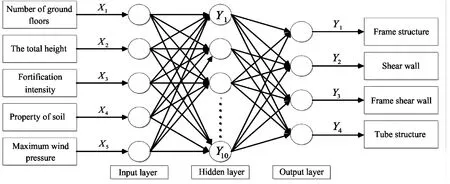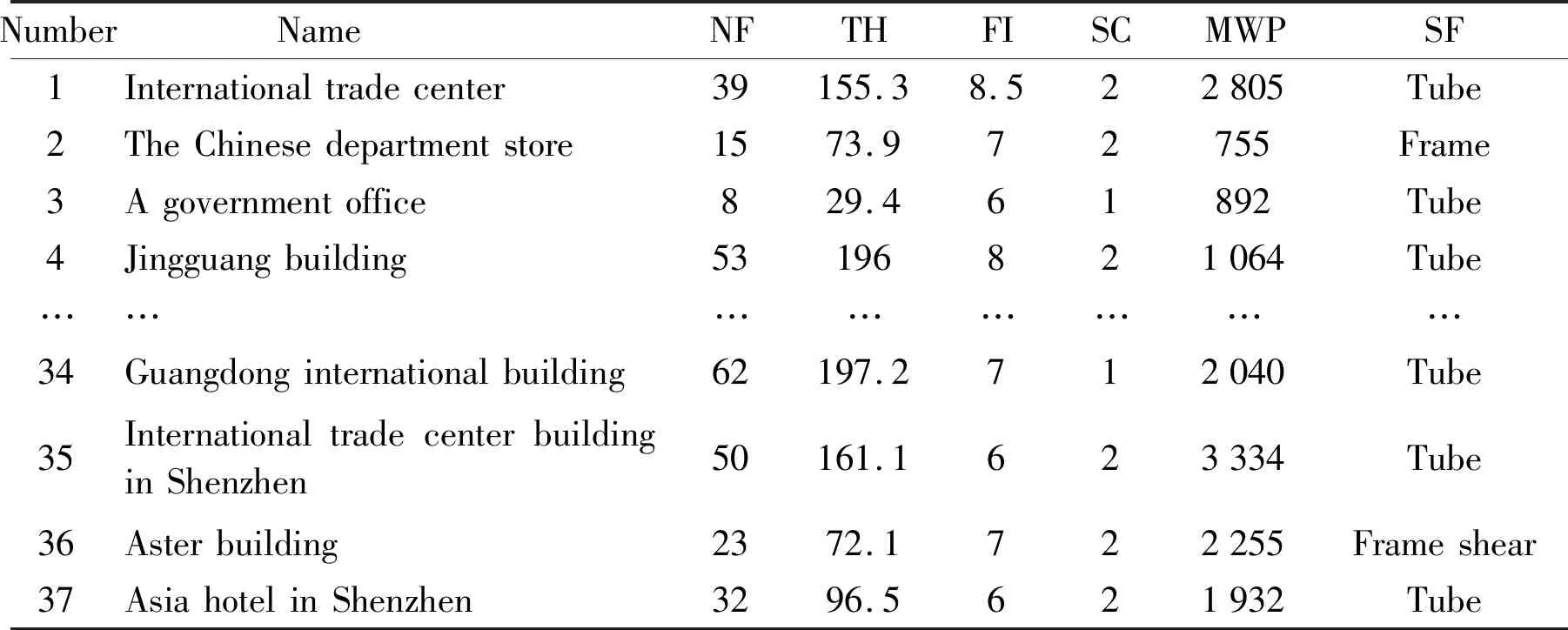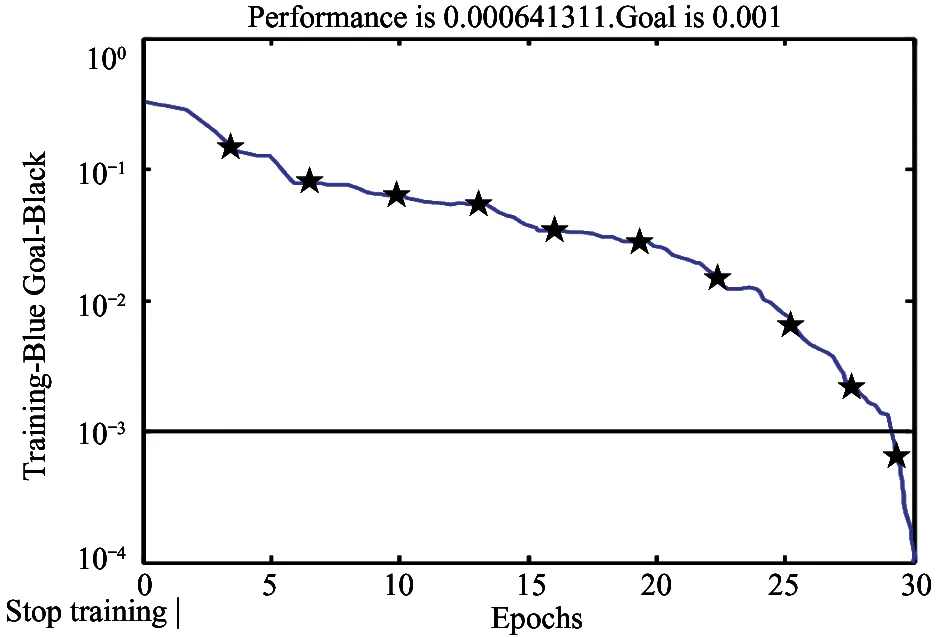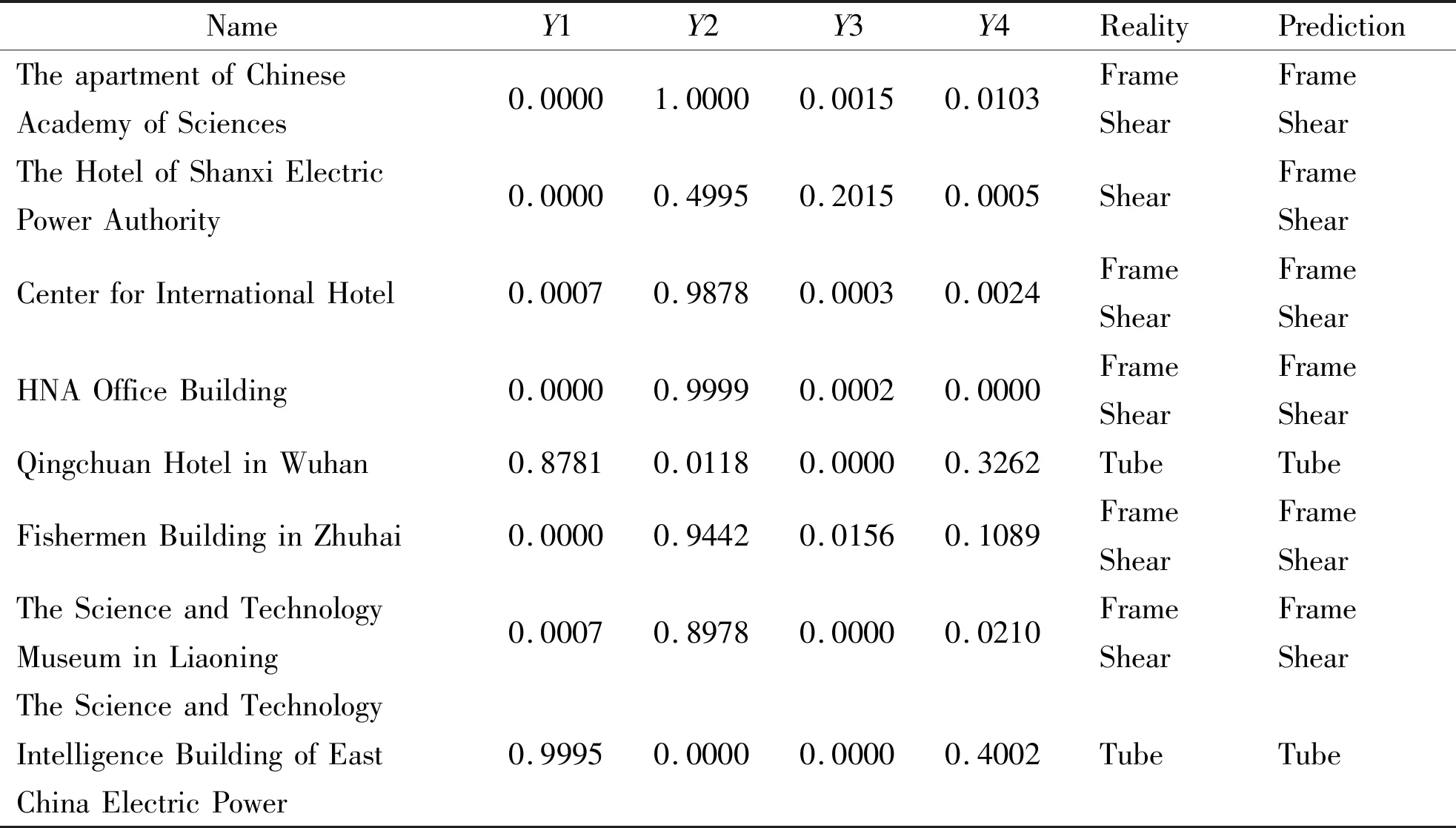Structural form selection of the high-rise building with the improved BP neural network①
Zhao Guangzhe (赵光哲),Yang Hanting,Tu Bing,Zhou Meiling,Zhou Chengle
(*School of Electrical and Information Engineering,Beijing University of Civil Engineering and Architecture,Beijing 100044,P.R.China)(**College of Information and Communication Engineering,Hunan Institute of Science and Technology,Yueyang 414000,P.R.China)
Abstract
Key words:back propagation (BP) neural network,high-rise building,structural form selection,Levenberg-Marquardt (L-M) algorithm
0 Introduction
With the advancement of social productivity and modern science,especially in cities,more and more high-rise buildings have been built.They have many advantages,such as reducing land resource occupation,solving housing shortages,and beautifying the urban environment[1-3].Plenty of engineering experiences show that the design of high-rise buildings can be safe,economical and reasonable,the key lies in the structural scheme is selected properly.The scheme requires to consider the orientation of buildings,the surrounding environment,and other factors,so the knowledge involved is quite complicated[4-6].Furthermore,the difficulty of structural form selection will lead to an increase in time costs,and human and financial resources consumption.Therefore,how to choose a reasonable structural form of high-rise buildings is a problem worth studying[4-11].
As described above,the height and span of tall buildings are much larger than ordinary buildings,and the design of high-rise buildings also needs to consider more factors such as earthquake protection and typhoon prevention.Therefore,it is important to reduce redundant design elements and select the essential ones effectively[12,13].Maher[14]established a high-rise structural preliminary design expert system named HI-RISE in 1987.CADRE,a preliminary structural design system based on instances was also established in 1994[15].From 1998 to 2000,Soibelman[15]and Pena-Mora et al.[16]put forward and set up a distributed multiple-inference system that supports conceptual design of the high-level structure.However,in terms of structural selection of high-rise buildings,the theory is not thoroughly researched both at home and abroad as it is a very complicated decision-making problem that contains a lot of uncertain information (i.e.,randomness,fuzziness,and uncertainties).So the optimization problem of structural form selection of high-rise buildings has been one of the challenging work in the engineering design process[12-17].
As the neural network method becomes prevalent,a part of inherent flaws has been explored.Zhang et al.[18]proposed a novel bidirectional active learning algorithm that examines both unlabeled and labeled datasets to address deterioration in the presence of noise.Zhang et al.[19]proposed an interactive patent classification algorithm based on multi-classifier fusion and active learning to handle the problem of low efficiency and high expense.Zhang et al.[20]proposed a novel indeterminate multi-class active learning algorithm effectively balanced between model update and model upgrade.
Through reading a lot of literature and analyzing the characteristics and applicable scope of the main structural form of high-rise buildings,the proposed methods extract the main controlling factors of the structural form selection of high-rise buildings.Then a structural form selection system of high-rise buildings based on the improved back propagation (BP) neuralnetwork algorithm by the Matlab neural network toolbox is established.The intelligent expert system for structural form selection in this work can effectively handle,discovery and reuse existing engineering examples of useful information,which will be a new research direction to improve design quality and efficiency[11,21-23].This system can be useful for optimizing the anti-seismic design of building shape and has positive significance to guide the seismic fortification of the urban high-rise building projects.
1 Method and materials
1.1 The improved BP neural network
BP neural network is composed of the input layer,hidden layer and output layer.The number of hidden layers will be one or more[21-24].For instance,supposei,j,tare the input layer,hidden layer and output layer of a 3 layers structure of BP neural network,respectively withn,p,qneurons.The nodes in one layer are unrelated,but prompt to connect to other nodes of the adjacent layer.
The implementation steps of BP algorithm are as follows.
Step1Calculate the output value of each layer neurons.
The output of hidden layer is presented by
(1)
(i=1,2,…,n,j=1,2,…,p,k=1,2,…,m)
(2)
(j=1,2,…,p,t=1,2,…,q,k=1,2,…,m)
Step2Calculate error function of each layer.
The error function of output layer is
(3)
The error function of hidden layer is
(4)

Step3Correct connective weights.
In general,the gradient descent method is employed to fix the connective weights of each layer[25-28].The correctional weights between the contiguous layers are
(5)
whereηis the learning rate.
Randomly selectmlearning samples as a mode from the training sample set,repeat steps 2-5 ,until all themmodes are completely trained,then fulfill around of training for the training sample set.
Step4Compute the global error functionEof network.

(6)
IfEis less than the preset smaller value,or to the preset maximum number of training,then stop learning.Otherwise,repeat steps 1-5,for the next round of training sample set.
Step5Load test samples to the BP network that has been trained,and output prediction results.
Traditional BP algorithm has defects such as slow convergence speed and local level extremum.Thus,it is difficult to work in practice which has real-time requirement.This paper uses Levenberg-Marquardt (L-M) algorithm to train the BP neural network because of its fast convergence and high accuracy[29-31].The iterative formula is
(7)
where,Iis the unit array,ηis a non-negative value.Depending on the amplitude ofη,the method smoothly changes between 2 extremes:namely Guass-Newton method (η→0) and the standard gradient descent method (η→∞),which can be used for training the BP neural network.
Change of network weights and bias is
(8)
Adjust the training network continuously,until achieving the goals.In fact,the L-M method is the combination of Newton method and the standard gradient descent method,which combines the advantage of the 2 methods.Therefore,the BP network designed by L-M algorithm has higher precision and faster convergence speed[32].
1.2 Materials and detailed realization
If all the factors that can be considered are input into the BP neural network as features,the scale of the model will be huge.And the convergence process will be tortuous which has the problem of dropping in the local minima.To accelerate the model training and do not lose the validity of the prediction,this article only chooses 5 main impact factors as the input features[10,11,33].The specific parameter values are as follows.
1) Number of floors:the upper number of buildings.
2) The total height of the building:the actual height of the building.
3) The fortification intensity:take actual fortification intensity.
4) Soil category:class foundation soil is set to 1;class foundation soil is set to 2;class foundation soil is set to 3.
5) The maximum wind pressure:according to the formulaWk=βzμsμzω0to calculate,where,βzis the gust response coefficient at height ofZ,μzis the height change coefficient of wind pressure,μsis the shape factor of wind load.
As shown in Fig.1,the neural network model of BP contains 3 layers.Number of ground floors is set asX1,the total height is set toX2,the fortification intensity is set asX3,the property of soil is set toX4,andX5represents the maximum wind pressure.Y1,Y2,Y3andY4represent the reduced feature of frame structure,shear wall frame,shear wall and tube structure resprectively.A feed-forward neural network with a hidden layer has been used here,whose structure for the number of neurons in the input layer is 5,the number of neurons in the hidden layer is 10,the number of output layer neurons is 4.The output structural forms contain frame structure,shear wall,frame shear wall,and tube structure.
In order to establish and train neural networks,the model randomly chooses a variety of different structures of high-rise buildings as samples from the instance set for the design of high-rise building structure[13],a total of 37 samples are shown in Table 1.
NF stands for Number of floors;TH stands for total height (m);FI is fortification intensity;SC stands for soil category;MWP is maximum wind pressure (N/m2);SF is structural form.

Fig.1 The proposed BP neural network model with 5 input building features and output 4 control factors

Table 1 Samples of high-rise buildings
In these samples,22 samples have been selected randomly to train the network,each sample has 5 input nodes,representing the impact factors.There are 4 output nodes,which is the structural form of high-rise building.The quantitative relation is as follows:tube structure for [1,0,0,0],frame shear wall for [0,1,0,0],shear wall structure as the [0,0,1,0],and frame structure for [0,0,0,1].The input vector of neural network isP=[P1,…,P17] and the output vector isT=[T1,…,T17].The remaining 15 samples as a prediction sample are set to make a p-test.
This work applied the newff function in the Matlab neural network toolbox to establish the BP neural network (Matlab R2011b,Math Works Inc.,Natick,MA).The number of neurons of the hidden layer and the output layer is 4 and 10 respectively.The neuron transfer function of the hidden layer is a logsig function,while the output layer is a tansig function.Because the L-M algorithm is applied to train the BP network,so the training function of the BP network is trainlm.The precision of required training goal=1e-3.In order to decrease the size variance of the input data,guarantee the training speed and accuracy of the network,the input vector is normalized by invoking premix function,and all the parameters are projected on range of (-1,1).After the network is set up,train function in the neural network toolbox has been launched for training the BP neural network.
2 Results
The network training process curve is shown in Fig.2,the blue curve decreased slowly at the beginning,then became very fast when reaching the training goal.The remaining 15 samples as a prediction sample were set to make a p-test = [p-test1,…,p-test15],as shown in Table 2.Each prediction sample was normalized before input the neural network.From Table 2,it shows that 15 samples only the prediction result of sample 2 was wrong,the accuracy of structural form prediction reaches 93.33%.However,if increase the number of samples,the prediction results will be more accurate.So that the structural form selection of the high-rise building with the improved BP neural network is feasible,and has the high accuracy.

Fig.2 The network training process curve

Table 2 The prediction results of BP neural network
3 Discussions
This research performs structural form selection of the high-rise buildings based on the improved BP neural network using 37 samples.Artificial neural network is established to classify 15 high-rise building samples,only one prediction result is wrong.Thus the accuracy of structural form prediction reaches 93.33%.However,the traditional BP algorithm has defects such as slow convergence speed and local level extremum,the model has improved the algorithm by using the L-M algorithm to train the BP neural network with fast convergence and high accuracy.
From this study,an artificial neural network expert system can be developed for the structural form selection of high-rise buildings.Based on the improved BP neural network model combined with Matlab’s GUI,it will be easier to build the artificial neural network expert system with an excellent human-computer interaction interface.If model takes input of correlation factors of a sample which contains Number of floors,the total height of the building,the fortification intensity,the property of soil,and the maximum wind pressure,the structural form of the high-rise building can be predicted precisely.In accordance with the above introduction,if the related data of the prediction sample project is taken into account,the final selection results of the expert system will be shown on the output interface.The results show that the system performance is good,and achieves the goal of the intelligent prediction.
Despite the 5 main factors which affect the structural form of high-rise buildings,basic forms,forms of floor slabs and material type will play essential roles in selecting the structural form.These factors will be added in future work,and the structure of the BP network must be altered in such condition.Furthermore,if more samples for training the parameters of the BP network are collected,in that case,the accuracy of structural form prediction will be increased.Whatever,the results will be helpful for architects,structural engineers,and other relevant people in the construction of the buildings.
4 Conclusions
The structural form selection of high-rise buildings is a wide range,strong comprehensive work,and needs various knowledge and rich experiences.In the current study,the method of prediction of the structure of high-rise building with the improved BP neural network to storage experts design experience has been proposed,and this system has the incremental learning function.The method can help building designers to choose an appropriate structure,so the application of neural networks for the choice of the structural form of high-rise buildings has important significance.
 High Technology Letters2020年1期
High Technology Letters2020年1期
- High Technology Letters的其它文章
- End-to-end verifiable electronic voting scheme of blockchain based on random linear block code①
- Improved Fx-VSSLMS algorithm for active vibration control of smart cantilever beam①
- Modal analysis of the torque converter in different prestress①
- Decision-feedback subset aided multiple-symbol differential detection①
- A new diagnosis strategy under the PMC model and applications①
